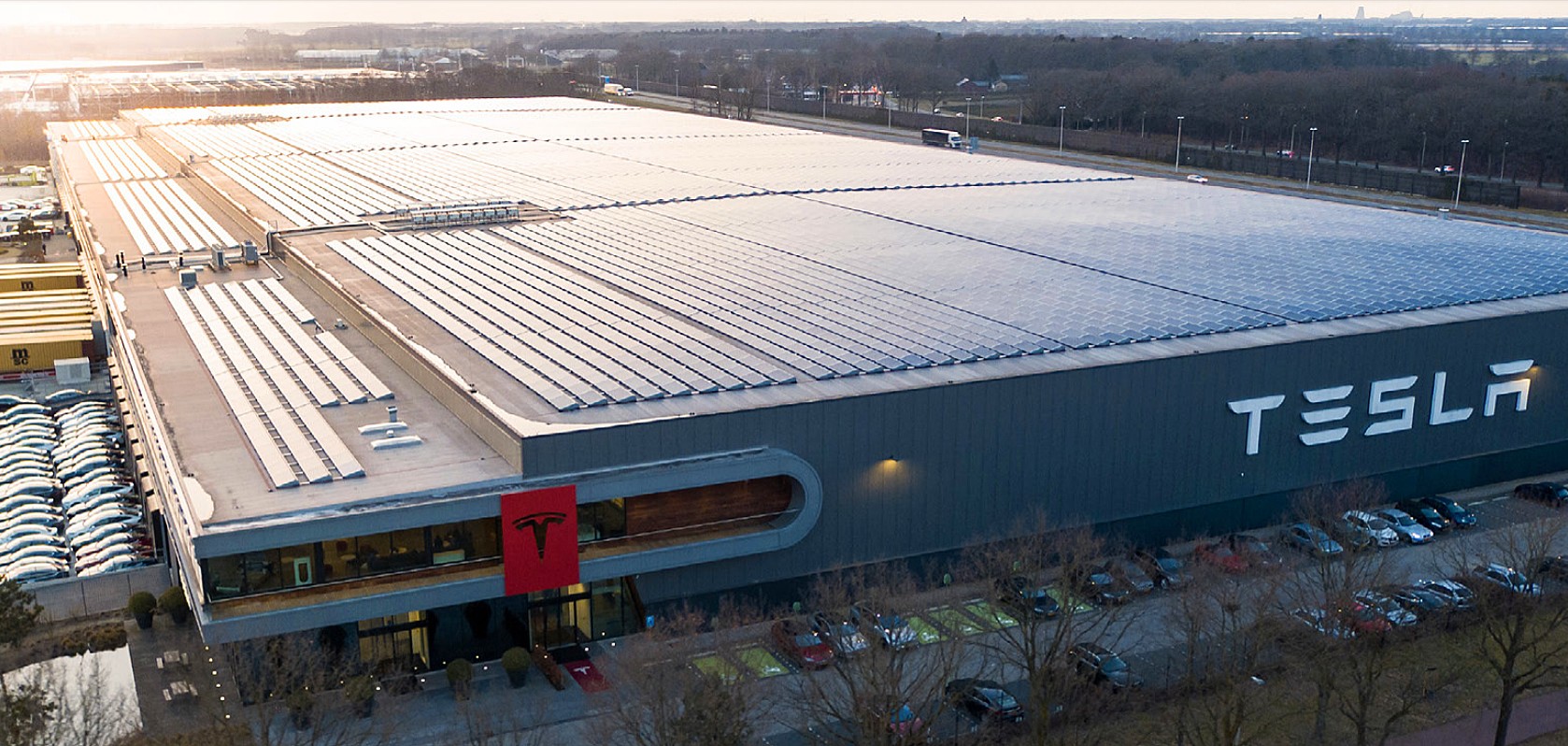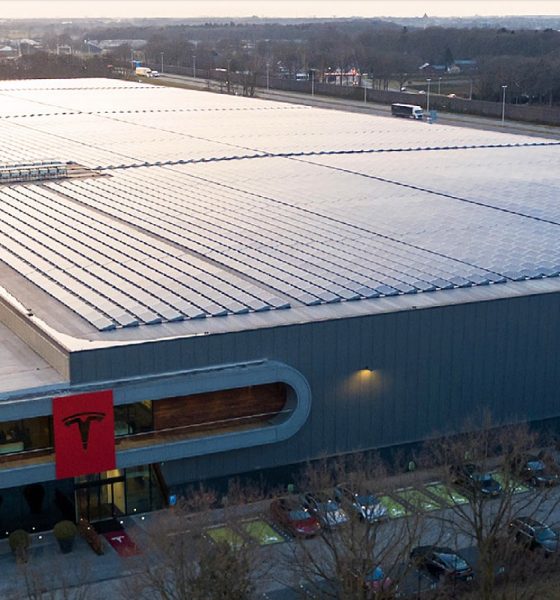

News
Tesla Gigafactory UK? Elon Musk’s quick stop in England drives rumors
Rumors of a Tesla Gigafactory in the United Kingdom are surging after a brief visit from CEO Elon Musk in Luton, a town in South East England. Musk made the visit on his way to Germany, where he was set to visit Tesla’s Giga Berlin production facility.
Earlier this week, Tesla CEO Elon Musk visited Giga Berlin, but he stopped in the UK for a short time, according to his plane tracker. Musk landed at London Luton Airport on May 14th and stayed for two days before loading back up into his Gulfstream G650 and heading off to Berlin Brandenburg Airport on Sunday.
Tesla CEO Elon Musk receives rockstar welcome in first visit to Giga Berlin
Questions surfaced about the reason for Musk’s two-day stay in the UK, and it may have something to do with a potential UK Gigafactory that could help supplement European demand for Tesla’s electric cars. According to a report from The Telegraph, regional authorities in Teesside and the West Midlands were given 48 hours to prepare a 250-hectare site. The report stated that the entities in control of the land were not informed of who or what was visiting the land or what company would potentially bid on the land that they had prepared.
The communications to the landowners, along with the rest of the process, were set up by the newly-formed Office for Investment, a government office that handles discussions between private foreign investors and the public sector.
Speculation regarding a potential Tesla Gigafactory in the UK started last year in May when a Department for International Trade (DIT) in the UK was leading a search for a plot of land that was big enough to house a large-scale electric vehicle manufacturing facility. A spokesperson for the DIT indicated that it was “working closely with partners to scope out sites for new investment into electric vehicle research, development, and manufacturing across the UK.”
According to the May 2020 report, one business park in Somerset, a county in South West England, attempted to lure Tesla to its 650-acre site, which is slightly smaller than the 740-acre Giga Berlin property, comfortably bigger than Tesla’s Fremont Factory that sits on only 370 acres. Earlier this year, Minister of State for Business Kwasi Kwarteng offered his support for the potential Tesla facility. Kwarteng said that Somerset has the “manufacturing skill and competence to be able to sustain an excellent Gigafactory.”
Neither Tesla nor its CEO Elon Musk has commented on the potential for the UK Gigafactory, nor is it confirmed that either entity is planning to purchase land for a new factory in the region.
Currently, Tesla has five Gigafactories; three of them are currently active: Gigafactory Nevada, Gigafactory Buffalo, and Gigafactory Shanghai are currently active. Gigafactory Berlin and Gigafactory Texas are still under construction, and plans for a new Gigafactory in India have also circulated for the past few months.
Europe is one of the largest markets for electric vehicles, and Tesla could handle demand without issue if it had two Gigafactory facilities in the region. As electric vehicles take off in popularity, Tesla leads the charge globally and plans to expand its already impressive lineup of production facilities will only accelerate the transition to electrification.
What do you think? Let us know in the comments below, or you can email me at joey@teslarati.com or Tweet me @KlenderJoey.

News
Tesla is seeing a lot of momentum from young Koreans in their 20s-30s: report
From January to November, young buyers purchased over 21,000 Teslas, putting it far ahead of fellow imported rivals like BMW and Mercedes-Benz.

Tesla has captured the hearts of South Korea’s 20s-30s demographic, emerging as the group’s top-selling imported car brand in 2025. From January to November, young buyers purchased over 21,000 Teslas, putting it far ahead of fellow imported rivals like BMW and Mercedes-Benz.
Industry experts cited by The Economist attributed this “Tesla frenzy” to fandom culture, where buyers prioritize the brand over traditional car attributes, similar to snapping up the latest iPhone.
Model Y dominates among young buyers
Data from the Korea Imported Automobile Association showed that Tesla sold 21,757 vehicles to the 20s-30s demographic through November, compared to BMW’s 13,666 and Mercedes-Benz’s 6,983. The Model Y led the list overwhelmingly, with variants like the standard and Long Range models topping purchases for both young men and women.
Young men bought around 16,000 Teslas, mostly Model Y (over 15,000 units), followed by Model 3. Young women followed a similar pattern, favoring Model Y (3,888 units) and Model 3 (1,083 units). The Cybertruck saw minimal sales in this group.
The Model Y’s appeal lies in its family-friendly SUV design, 400-500 km range, quick acceleration, and spacious cargo, which is ideal for commuting and leisure. The Model 3, on the other hand, serves as an accessible entry point with lower pricing, which is valuable considering the country’s EV subsidies.
The Tesla boom
Experts described Tesla’s popularity as “fandom culture,” where young buyers embrace the brand despite criticisms from skeptics. Professor Lee Ho-geun called Tesla a “typical early adopter brand,” comparing purchases to iPhones.
Professor Kim Pil-soo noted that young people view Tesla more as a gadget than a car, and they are likely drawn by marketing, subsidies, and perceived value. They also tend to overlook news of numerous recalls, which are mostly over-the-air software updates, and controversies tied to the company.
Tesla’s position as Korea’s top import for 2025 seems secured. As noted by the publication, Tesla’s December sales figures have not been reported yet, but market analysts have suggested that Tesla has all but secured the top spot among the country’s imported cars this year.
News
Tesla FSD fleet is nearing 7 billion total miles, including 2.5 billion city miles
As can be seen on Tesla’s official FSD webpage, vehicles equipped with the system have now navigated over 6.99 billion miles.

Tesla’s Full Self-Driving (Supervised) fleet is closing in on almost 7 billion total miles driven, as per data posted by the company on its official FSD webpage.
These figures hint at the massive scale of data fueling Tesla’s rapid FSD improvements, which have been quite notable as of late.
FSD mileage milestones
As can be seen on Tesla’s official FSD webpage, vehicles equipped with the system have now navigated over 6.99 billion miles. Tesla owner and avid FSD tester Whole Mars Catalog also shared a screenshot indicating that from the nearly 7 billion miles traveled by the FSD fleet, more than 2.5 billion miles were driven inside cities.
City miles are particularly valuable for complex urban scenarios like unprotected turns, pedestrian interactions, and traffic lights. This is also the difference-maker for FSD, as only complex solutions, such as Waymo’s self-driving taxis, operate similarly on inner-city streets. And even then, incidents such as the San Francisco blackouts have proven challenging for sensor-rich vehicles like Waymos.
Tesla’s data edge
Tesla has a number of advantages in the autonomous vehicle sector, one of which is the size of its fleet and the number of vehicles training FSD on real-world roads. Tesla’s nearly 7 billion FSD miles then allow the company to roll out updates that make its vehicles behave like they are being driven by experienced drivers, even if they are operating on their own.
So notable are Tesla’s improvements to FSD that NVIDIA Director of Robotics Jim Fan, after experiencing FSD v14, noted that the system is the first AI that passes what he described as a “Physical Turing Test.”
“Despite knowing exactly how robot learning works, I still find it magical watching the steering wheel turn by itself. First it feels surreal, next it becomes routine. Then, like the smartphone, taking it away actively hurts. This is how humanity gets rewired and glued to god-like technologies,” Fan wrote in a post on X.
News
Tesla starts showing how FSD will change lives in Europe
Local officials tested the system on narrow country roads and were impressed by FSD’s smooth, human-like driving, with some calling the service a game-changer for everyday life in areas that are far from urban centers.

Tesla has launched Europe’s first public shuttle service using Full Self-Driving (Supervised) in the rural Eifelkreis Bitburg-Prüm region of Germany, demonstrating how the technology can restore independence and mobility for people who struggle with limited transport options.
Local officials tested the system on narrow country roads and were impressed by FSD’s smooth, human-like driving, with some calling the service a game-changer for everyday life in areas that are far from urban centers.
Officials see real impact on rural residents
Arzfeld Mayor Johannes Kuhl and District Administrator Andreas Kruppert personally tested the Tesla shuttle service. This allowed them to see just how well FSD navigated winding lanes and rural roads confidently. Kruppert said, “Autonomous driving sounds like science fiction to many, but we simply see here that it works totally well in rural regions too.” Kuhl, for his part, also noted that FSD “feels like a very experienced driver.”
The pilot complements the area’s “Citizen Bus” program, which provides on-demand rides for elderly residents who can no longer drive themselves. Tesla Europe shared a video of a demonstration of the service, highlighting how FSD gives people their freedom back, even in places where public transport is not as prevalent.
What the Ministry for Economic Affairs and Transport says
Rhineland-Palatinate’s Minister Daniela Schmitt supported the project, praising the collaboration that made this “first of its kind in Europe” possible. As per the ministry, the rural rollout for the service shows FSD’s potential beyond major cities, and it delivers tangible benefits like grocery runs, doctor visits, and social connections for isolated residents.
“Reliable and flexible mobility is especially vital in rural areas. With the launch of a shuttle service using self-driving vehicles (FSD supervised) by Tesla in the Eifelkreis Bitburg-Prüm, an innovative pilot project is now getting underway that complements local community bus services. It is the first project of its kind in Europe.
“The result is a real gain for rural mobility: greater accessibility, more flexibility and tangible benefits for everyday life. A strong signal for innovation, cooperation and future-oriented mobility beyond urban centers,” the ministry wrote in a LinkedIn post.








